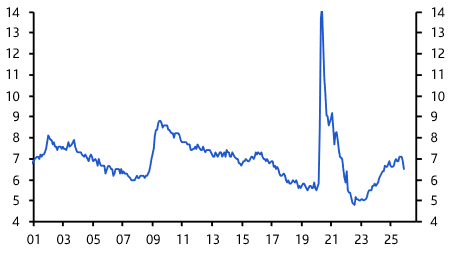It sometimes feels as though there is little more to be said about the outlook for inflation, such has been the volume of ink spilt on the subject in recent weeks. However, much of the discussion has tended to miss important nuances in the situation faced by different countries. Two points are worth keeping in mind as the debate continues to unfold.
The first is that the effects of the pandemic – and measures to contain it – are distorting the data we normally rely on to track the evolution of inflation pressures. This applies to the inflation data itself, but also to other important data, notably on the labour market. And the nature and extent of these distortions varies between countries.
We’ve covered problems in the production of the inflation data in detail elsewhere. The nub of the issue, however, relates to the difficulties in capturing prices during lockdowns – if goods or services are not available to purchase then it is impossible for the statisticians to measure their price. This was a particular challenge in Europe, which enforced much tougher lockdowns than in the US. Statistics offices in Europe responded by imputing prices for items that could no longer be purchased. In contrast, lighter touch lockdowns meant that the statisticians in the US were better able to capture the full extent of price falls in categories most affected by pandemic-related restrictions, such as airfares. As a result, there is now much greater scope for “measured” inflation in the US to rebound as restrictions are lifted.
Meanwhile, pandemic support programmes are distorting the labour market data policymakers and investors rely on to judge levels of spare capacity – and thus underlying inflation pressure – in economies. This is particularly true in the US, where support came in the form of expanded unemployment insurance rather than government-backed furlough schemes. Not only does this mean that unemployed workers have become disconnected from jobs, thus creating friction in the labour market, but it’s possible that the generosity of the expanded benefits may be discouraging laid-off employees from seeking new work as firms rehire. This should dissipate as the expanded benefits end over the coming months, but in the meantime it may be exaggerating the true extent of tightening in the US labour market.
This embodies the broader problem posed by pandemic-related data distortions: while they should ultimately prove transitory, they will complicate efforts to track the true strength of price pressures. This in turn will pose communication challenges for central banks and could, in the extreme, increase the risk of policy mistakes. Given the nature of the data distortions, these challenges will be more acute in the US than in Europe. Yet this is something that has been almost entirely absent from the recent debate.
The second point that has often been missed is arguably even more important. It relates to underlying inflation dynamics in different economies. Pandemic-related supply shortages have caused a rise in the price level for particular goods and services across most economies. But inflation should be thought of as a process of widespread and continuous price increases. This requires aggregate demand to run ahead of potential supply for a sustained period. And it is more likely to materialise in an economy in which policy settings are too loose.
Viewed through this lens it is striking how little consideration has been given to the vast differences in the scale of policy stimulus seen across advanced economies. (See Chart 1.) This may be because stimulus everywhere has been huge, making it difficult to grasp the true scale of differences between countries. In Germany, for example, fiscal stimulus measures aimed at shoring up demand during the pandemic have been equivalent to nearly 10% of GDP. That’s five times the size of Germany’s stimulus in the wake of the global financial crisis in 2009-10, making it enormous by any normal yardstick. But the US fiscal stimulus during the pandemic has now totalled 25% of GDP. Germany’s support may have been enormous, but US support has been off the scale. Add in the prospect of a strong rebound in private sector demand and the fact that, even accounting for data distortions, there is growing evidence of labour shortages in the US, and it means that the risks of a sustained period of higher inflation are significantly greater in America than in other advanced economies.
Chart 1: Discretionary Fiscal Response to COVID-19 (Extra Spending & Foregone Revenue % of GDP)

Sources: IMF, Capital Economics
Put all of this together and what emerges is a more complicated picture than the current polarised debate around inflation suggests. Inflation is likely to rise everywhere over the coming months as the effects of higher global commodity prices feed through and supply shortages push up prices. But the situation beyond the next six to 12 months is more nuanced – and a more considered approach suggests the US should be the focus of concern.
In case you missed it:
- Our Chief Asia Economist, Mark Williams, argues that chip shortages will persist for some time to come.
- Our Senior China Economist, Julian Evans-Pritchard, says that China’s vaccine surge means it is now responsible for half of the world’s daily inoculations.
- Our Markets Economist, Tom Matthews, argues that long-term real yields in the US are likely to grind higher over the rest of this year.



